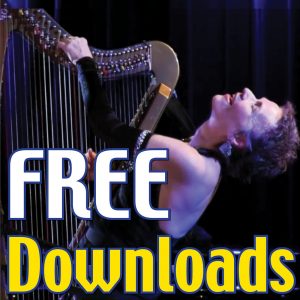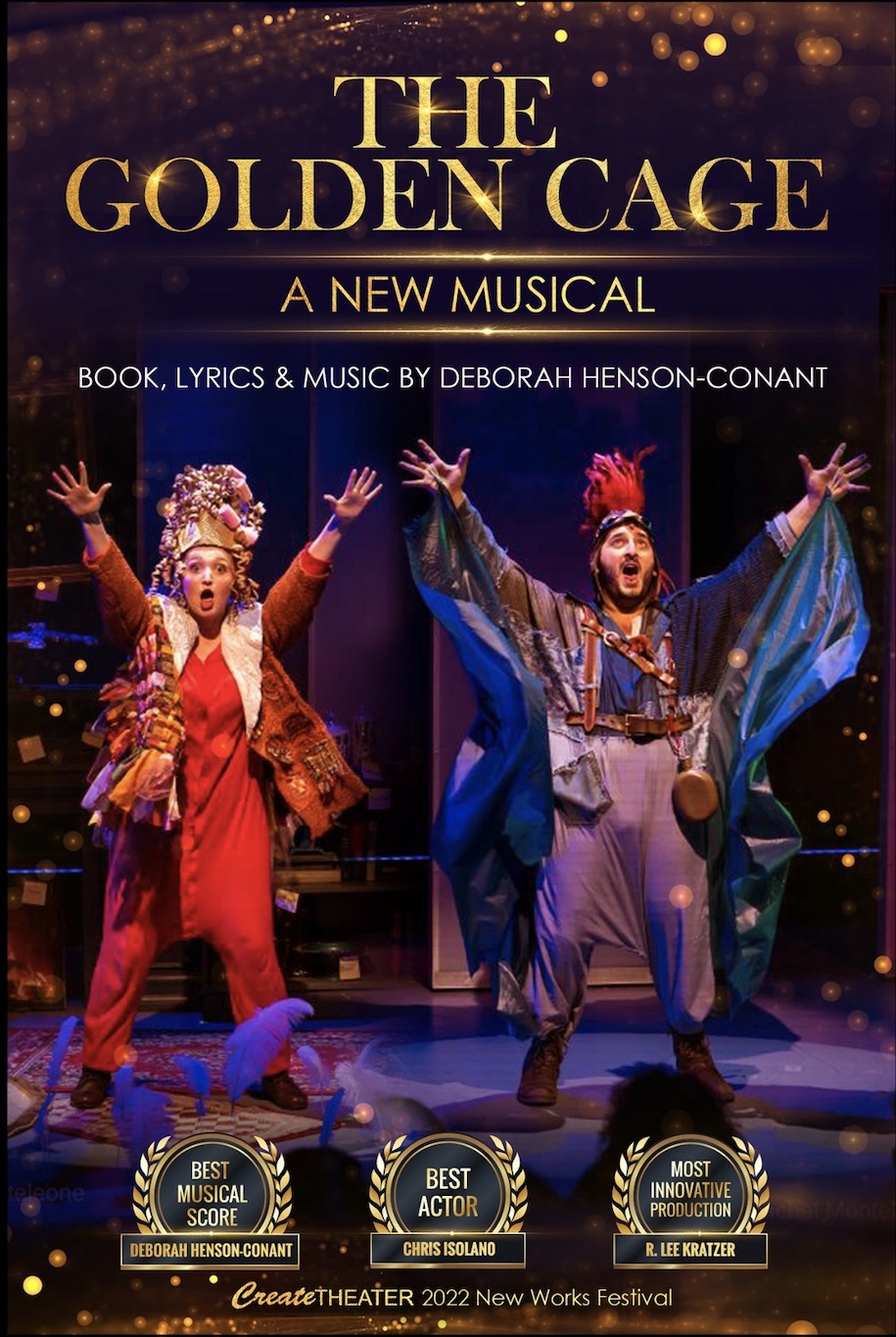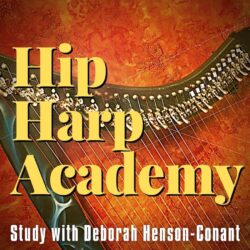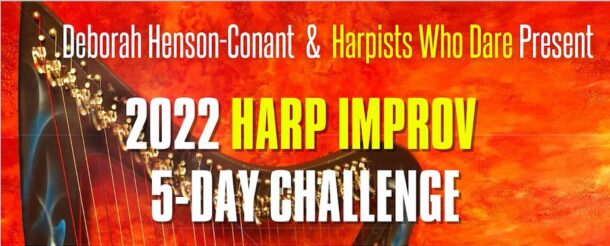I’m so happy to share some of the Final-Beginning Projects from this year’s “Summer Program” at Hip Harp Academy. These are all Music Projects by members of Hip Harp Academy – harpists committed to liberating themselves from the notes on the page and creating their own arrangements.
We call them ‘Final-Beginning’ projects, because, while they’re the final project of this class, the point of the project is to create a new beginning – a place to start the next phase of their creative journey – and the commitment for everything in the program is Connection – not Perfection.
Below each video you’ll get to learn – in each players own words – what they’re playing, their challenges in creating this project and what their ‘aha’s and takeaways’ were. Readers, please add your own ‘Aha’s & Takeawys’ in the comments below.
Join us for the NEXT Class in Hip Harp Academy:
Hip Harp Toolkit.
You’ll see a huge diversity
Students of all technical levels take this class – and they all use the same principles to create their projects. You’ll see projects from advanced players, and from ‘fledgling’ players who’ve started their harp journey in the 2nd or 3rd acts of life. You’ll see projects from people who’ve played all their lives – and from people who left the instrument for decades and then returned. They’re all working from the same principles I teach in the class – and you’ll get to see how they each use those to create arrangements at their own level of technical ability.
They’ve also all committed to creating these arrangements ‘off the page’ – so they’re not playing written arrangements, but simply using what they learned to create a spontaneous arrangement, that will be different each time they play it.
One of my favorite parts of these projects is reading what the students write about their journey to creating this video – and I ‘ve included their answers to the questions I ask about that in the dropdown below each video.
I’ve included all the projects that were shared this year – usually 10% – 15% of people in the class share a project – and I also included a few projects I really love from previous years.
A few years ago, when I was explaining to a non-harpist friend how much I enjoy these projects, and seeing everyone taking the same concepts and bringing them alive with different tunes, skillsets, levels of technical proficiency, and in different settings – I showed my friend some of the projects and after looking at the page she blurted out:
“Oh, I love it! These are real people!”
In one short sentence she put into words why people find these videos so inspiring: These truly are real people, often people who are expert at something completely different in life, sometimes adult beginners who have only played the harp for a year or two – sometimes advanced players who are challenging themselves to break away from the security of written notes — all of whom are investing themselves, heart and soul in expressing themselves with an instrument that’s as tricky as it is beautiful.
Yes, thse are TRULY real people, and they’re sharing the beauty of that realness with all of us. This is a real gift.
Sally Walstrum
Sally studied classical harp as a young girl, then left it and has now returned. In this video she starts out with a short snippet of one of first classical pieces she ever played, “The Little Fountain” by Samuel O. Pratt, then transitions to a new key to play ‘Black Orpheus’ in a style that combines classical and latin jazz. Her summer project was about connecting her classical roots with her love of rhythm and jazz.
Read Sally's Insights about this Project (click to open)
Describe your final project so I know exactly what you’re sending me.
This project came about when I was attempting an arrangement of “Black Orpheus” said something to DHC about struggling with other styles due to being a very classically trained harpist. DHC suggested that I try a formula in which I start out with a little bit of classical music (a short snippet of “The Little Fountain” by Samuel O. Pratt), transition to a new key, and then try to play “Black Orpheus” in a more classical style. There’s a vamp between the two sections of “Black Orpheus” over which there is an exploration.
What principles from this course or from chats did you use to develop, perform, and record this project – and how did they play a part in your process?
I tried to work with exploring/improvising over a vamp vs. the roadmap of the tune.
Give a short description of what it took for you to be able to play what you did – both logistically and emotionally.
I used DHC’s suggestion to put on a timer and play the vamp / improv section over & over, which helped with the logistics. Emotionally, I realized that I had to push through regardless of mistakes.
What freedoms and blocks within yourself did you connect with (or struggle with) in the process?
I struggled both with the idea of taking this Latin tune and playing it rubato. I still wonder if I’m rushing it. I also had difficulty with keeping the left hand vamp going in the improvisation. I had to let go of that inner voice that tends to want perfection.
What challenges did you meet while connecting with your own freedom of expression in this project?
I think my biggest challenge was to stop worrying about the improvisation. I was eventually able to let go and go for it.
What other parts of your life were impacted by what you learned in this class, and how?
I think it was about gaining a bit more confidence with the realization that I can do a project like this and by extension, I can do other things I never thought possible.
What were your personal “Ahas”?
It’s not about me but about the music and the impact of sharing the music might have on a listener.
Margi Miller
Margi’s created a show especially for audiences who are 90 years and older in an assisted living home – and this is “sing along” piece with a portable harp is all about engaging people in song and music. Her summer project was to work on playing and singing while truly being able to focus on the people she’s playing for (no small feat!)
Read Margi's Insights about this Project (click to open)
What principles from this course or from chats did you use to develop, perform, and record this project – and how did they play a part in your process?
I am trying to learn 3 chord magic or at least chording simple enough so that I can concentrate on singing and looking at my audience and not have to bury myself in the strings.
Give a short description of what it took for you to be able to play what you did – both logistically and emotionally.
This is the first time I have concentrated on singing and playing at the same time. It was a real challenge because I either didn’t like my voice or didn’t like how little the harp parts played. Plus, there were THREE things to memorize: the melody, the words, the chords!
What freedoms and blocks within yourself did you connect with (or struggle with) in the process?
It always looks so easy when others do this. I couldn’t believe how hard it was. When I whittled it down to a really simple song, I had a kind of a breakthrough.
What challenges did you meet while connecting with your own freedom of expression in this project?
I tried this out “in public” with a group I usually just accompany (while my partner sings). I realized that the connection with the audience sort of takes over and the music and harp sort of fall in place.
What other parts of your life were impacted by what you learned in this class, and how?
I realized that “being with” your audience even when not doing music, is of utmost importance.
What was your personal “Ahas”?
I’m thinking I could really even just pick up my harp or a guitar at a party and play “happy birthday” on the spur of the moment. What a concept!!!! It might even go from there to lullabies, dance music…. who knows?
Is there anything else you want people to know when they watch your video?
I had to make a couple of cuts in the music to shorten it… They will be obvious.
Vera Stern
Vera – a long-time classical harpist and Qigung teacher – has recently discovered her love of composition. Her summer project was to complete the composition of her original arrangement of the traditional Yiddish Lullaby Rayzele.
Read Vera's Insights about this Project (click to open)
Describe your final project so I know exactly what you’re sending me.
This is the completed arrangement composition of the traditional Yiddish Lullaby Rayzele.
What principles from this course or from chats did you use to develop, perform, and record this project – and how did they play a part in your process?
This was not easy, we talked and practiced vamps.
But in the first chat, we worked on l vl v ( 145) bass vamp using it for various rhythms. This traditional song is based on a minor key using
145 ( Tonic, subdominant, dominant)
Give a short description of what it took for you to be able to play what you did – both logistically and emotionally.
The melodic variations were my lead and I tried to use the harmony in as many different formats as possible because I felt restricted by the minor key. Used the 7th off the beat mostly, using the dominant with the raised fifth.i also used the harmonic structure of a chord as bridges between various sections ( spreading the notes in rhythm between the left hand and right hand)
What freedoms and blocks within yourself did you connect with (or struggle with) in the process?
Coming up with satisfying harmonic support for the variations I composed was not easy and I also had to find a way to bridge between them without getting out of style
What challenges did you meet while connecting with your own freedom of expression in this project?
I had ideas/pictures of the mother dancing … fleeting moments of imagination in her own mind…maybe more like enchantments. That was very intensive work on the structure of the composition expressing different moods/ feelings
What other parts of your life were impacted by what you learned in this class, and how?
Our persona is the vamp as we go through life-changing clothes, moods, words, activities, dreams we are the same person …. it takes a lot to discover who we are these classes have been instrumental for me allowing me to listen to my music and give it expression.
What was your personal “Ahas”?
Yes, I can!
Debra Sawyer
Debra’s summer project is “A Solo Summer” – developing a solo repertoire of jazz tunes for harp and voice. In this video she’s playing “Fly Me to the Moon”
Read Debra's Insights about this Project (click to open)
Describe your final project so I know exactly what you’re sending me.
My Summer project was a Solo Summer – going out and performing in different venues, working up a set list and crafting that set list with all the principals and techniques I have learned through HHA
What principles from this course or from chats did you use to develop, perform, and record this project – and how did they play a part in your process?
Utilizing vamps within the pieces I have been working on, deconstructing each piece to its simplist form allowing me to relax, play and sing, or just play. Slowing down, taking time, breathing into a song or piece and constantly deconstructing —
Give a short description of what it took for you to be able to play what you did – both logistically and emotionally.
I had to re chart the piece because I don’t know it by heart and I should. I had to make it simple enough to get in chunks. The act of doing helps me figure out what I need to do to make it more comfortable. I love to perform. Strengthening the performance is feeling confident and comfortable with what you are performing.performing.
What freedoms and blocks within yourself did you connect with (or struggle with) in the process?
My freedoms are in the improvization I am capable of adding. The blocks are not knowing the structure well enough of each tune to let go of the sheet. A big set list for an hour. But I am working each piece and eliminating what doesnt work, what is too hard to perform.
What challenges did you meet while connecting with your own freedom of expression in this project?
Being confident of structure which gives me the ability to stay in rhythm, improvize on harp and start to get a little looser with the voice.
What other parts of your life were impacted by what you learned in this class, and how?
I realize if I want to perform on the harp I have to really structure my practice and go deep into each piece – deconstructing, charting etc. The impact too was selling myself, marketing. But the product has to border on excellent. All me. So Im “all shook up!!” in the process of becoming.
What were your personal “Ahas”?
I cant see a damn thing when I am standing, playing, singing and connecting with audience. My challenge is to imbed the sings that are going to stick and finish the songs I have started to. But this is all about developing chops. So all worth it.
Is there anything else you want people to know when they watch your video?
I just got back from a 8 day kayak expedition in the san Juan Islands Pacific Northwest, I have been tired since I got home. Jumpinh back on the harp and scheduling gigs and teaching all landed when I got home. So I need some deep sleep for sure.
Barbara
Barbara’s summer challenge was to create a simple arrangement of a piece she loves – “Sentimental Journey” – make the lever change while playing and have fun!
Read Barbara's Insights about this Project (click to open)
I tried to keep it simple and not incorporate more than I could play at this moment.
Give a short description of what it took for you to be able to play what you did – both logistically and emotionally.
I chose to omit the vocal emphasis in order to concentrate on the new suggestions Deborah had given me in the feedback from the Half-bake.
What freedoms and blocks within yourself did you connect with (or struggle with) in the process?
I felt freer to improvise some, to connect with the rhythm and to let some mistakes remain as part of my learning process. I did struggle with trying to figure out the notes Deborah had suggested because they varied quite a bit as she was working with the piece on my behalf.
What challenges did you meet while connecting with your own freedom of expression in this project?
In the Half-bake version, I was struggling with lever changes while trying to focus on so many things, including singing. In this Final Beginning Project, I released the need and desire to sing in order to work more on the chords, levers, and rhythm.
What other parts of your life were impacted by what you learned in this class, and how?
To submit the Half-bake took a huge amount of time and effort, for me, but with Deborah’s genuine and persistent encouragement, I managed to get it in.
What was your personal “Ahas”?
Aha! I found I could do more than I thought I could with the version I am submitting tonight.
Is there anything else you want people to know when they watch your video?
I felt there were some senior moments here and there and I was surprised how the piece was so different every time I practiced it, including rhythms, improvisation, notes, and errors. I did learn a lot in the process and realize it is still in the development stage.
I kept wondering: is this good enough? Should I do more? Should I have taken more time to learn more? All of this takes away from the enjoyment of playing.
And my personal “Aha’ was that Simple is best! It makes me happier.” (Margi Miller, Florida, USA)
Blythe Tait
Blythe has just bought a DHC electric body-harp (which you’ll see in the video) – and is making the transition from concert harp to wearing the DHC, amplifying both the harp and voice wirelessly, singing, using levers instead of pedals – and developing a repertoire to perform in shows and events. This video is her arrangement of “Georgia on My Mind.”
Read Blythe's Insights about this Project (click to open)
Describe your final project so I know exactly what you’re sending me.
Georgia On My Mind again, the whole song
What principles from this course or from chats did you use to develop, perform, and record this project – and how did they play a part in your process?
I think it was more Jazz For Harps! But the great thing about Summer Harp Jam is just DOING it, so that is what I applied here. Summer Harp Jam is also about PLAYING AROUND- so I applied that and played around with recording software, a mixing desk, wearing a harp, etc. Lots of new ‘playing around’. Also taking a roadmap of a song and building chord extensions and patterns around it.
Give a short description of what it took for you to be able to play what you did – both logistically and emotionally.
I DO NOT ENJOY playing around with sound gear, and it has taken a long time for me to start to apply myself to it. And as far as the song, I had to sit at the piano and work out chords and then work them out for the lever harp, so that was a good exercise.
What freedoms and blocks within yourself did you connect with (or struggle with) in the process?
Being scared of sound equipment!! And constantly worried about feedback- it is a phobia of mine.
What challenges did you meet while connecting with your own freedom of expression in this project?
I am still looking forward to playing around with improvising. I didn’t do that at all with this song BUT I didn’t really do a ‘set’ arrangement either, and that is a big step for me, just being aware of the chords and playing versions of them.
What other parts of your life were impacted by what you learned in this class, and how?
I can DO this. This could be something someone would want to watch. I am on the right track.
What was your personal “Ahas”?
I love standing with the harp. Once I fix up the line connections (I was getting some buzzing when I moved), I will be able to move around more.
Is there anything else you want people to know when they watch your video?
- I did this before I got Deborah’s half baked feedback, so the harp probably still sounds tinny, and I still have an instrumental intro.
2. I was getting cracking from one of the leads when I moved around, so I am more stationary than I would like. Looking forward to moving around!
3. I am excited about new harp possibilities!
Susan Regan
After a long career performing and teaching dance, Susan began playing harp in her 60’s, just few years ago – and is now committed to developing a show of music, stories – and dance – for senior living centers. This arrangement, Amazing Grace, is one she’s considering as a finale for her show.
Read Susan's Insights about this Project (click to open)
Describe your final project so I know exactly what you’re sending me.
For my final project, I am playing Amazing Grace which (I think) will be my finale for my senior show. I tried to incorporate some aspects from SHJ:
1-6-2-5
1-5-10
1-5-8
I also used a different octave, noodling, improvising and extending chords.
I would appreciate any help on my arrangement, chords, and playing.
What principles from this course or from chats did you use to develop, perform, and record this project and how did they play a part in your process?
Give a short description of what it took for you to be able to play what you did–both logistically and emotionally.
I’ve been working on a final piece for my senior show. I wanted it to be recognizable and meaningful to them, but also show some knowledge and some of my ability as a harpist. I’ve been working on it for at least 4 months and feel emotionally tied it because YOU started me on the path to playing it when I had my one on one lesson.
What freedoms and blocks within yourself did you connect with (or struggle with) in the process?
I only felt freedom when working on this piece because of SHJ, it’s progressions and the knowledge of
perfect imperfection.
What challenges did you meet while connecting with your own freedom of expression in this project?
The only challenge I had at times was that I questioned whether or not it was good enough, but I kept
hearing your voice telling me I was good enough.
What other parts of your life were impacted by what you learned in this class, and how?
I finally went to 4 senior centers this week and spoke to the Artistic Directors or left a packet with my brochure, card, cover letter and list of music that I play. Now, while I’m waiting to hear I’m working on a mailing to senior centers and nursing homes.
What was your personal “Ahas”?
I finally finished my summer project and I’m looking forward & moving forward toward my goal of a
Show for Seniors. “Aha,” I’m ready!!!!
“I learned the importance of elongating and decorating an otherwise mundane Christmas Carol by adding a beginning, ending and improvised section. Makes a BIG difference.” (Margi Miller, Florida USA)
PROJECTS & PERFORMANCES:
FOR HARPISTS:
- Join Hip Harp Academy
- Harp Time Live (FREE Weekly Playalong)
- FREE Resources













Real people, real inspirations each and everyone! Thank you!
I learn from you a lot. I’m still stuck in the past, but I’m inching out slowly. This is a big issue of trust as much as acceptance of where we ‘re really at…..